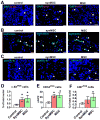Fabrication of Synthetic Mesenchymal Stem Cells for the Treatment of Acute Myocardial Infarction in Mice
- PMID: 28298296
- PMCID: PMC5488324
- DOI: 10.1161/CIRCRESAHA.116.310374
Fabrication of Synthetic Mesenchymal Stem Cells for the Treatment of Acute Myocardial Infarction in Mice
Abstract
Rationale: Stem cell therapy faces several challenges. It is difficult to grow, preserve, and transport stem cells before they are administered to the patient. Synthetic analogs for stem cells represent a new approach to overcome these hurdles and hold the potential to revolutionize regenerative medicine.
Objective: We aim to fabricate synthetic analogs of stem cells and test their therapeutic potential for treatment of acute myocardial infarction in mice.
Methods and results: We packaged secreted factors from human bone marrow-derived mesenchymal stem cells (MSC) into poly(lactic-co-glycolic acid) microparticles and then coated them with MSC membranes. We named these therapeutic particles synthetic MSC (or synMSC). synMSC exhibited a factor release profile and surface antigens similar to those of genuine MSC. synMSC promoted cardiomyocyte functions and displayed cryopreservation and lyophilization stability in vitro and in vivo. In a mouse model of acute myocardial infarction, direct injection of synMSC promoted angiogenesis and mitigated left ventricle remodeling.
Conclusions: We successfully fabricated a synMSC therapeutic particle and demonstrated its regenerative potential in mice with acute myocardial infarction. The synMSC strategy may provide novel insight into tissue engineering for treating multiple diseases.
Keywords: artificial cells; mesenchymal stem cells; myocardial infarction; regeneration; stem cells; tissue engineering.
© 2017 American Heart Association, Inc.
Figures




Comment in
-
Synthetic MSC? Nothing Beats the Real Thing.Circ Res. 2017 May 26;120(11):1694-1695. doi: 10.1161/CIRCRESAHA.117.310986. Circ Res. 2017. PMID: 28546347 Free PMC article. No abstract available.
-
Letter by Takov et al Regarding Article, "Fabrication of Synthetic Mesenchymal Stem Cells for the Treatment of Acute Myocardial Infarction in Mice".Circ Res. 2017 May 26;120(11):e46-e47. doi: 10.1161/CIRCRESAHA.117.311127. Circ Res. 2017. PMID: 28546360 No abstract available.
-
Response by Luo et al to Letter Regarding Article, "Fabrication of Synthetic Mesenchymal Stem Cells for the Treatment of Acute Myocardial Infarction in Mice".Circ Res. 2017 May 26;120(11):e48-e49. doi: 10.1161/CIRCRESAHA.117.311151. Circ Res. 2017. PMID: 28546361 Free PMC article. No abstract available.
Similar articles
-
Myocardial CXCR4 expression is required for mesenchymal stem cell mediated repair following acute myocardial infarction.Circulation. 2012 Jul 17;126(3):314-24. doi: 10.1161/CIRCULATIONAHA.111.082453. Epub 2012 Jun 9. Circulation. 2012. PMID: 22685115
-
Intravenously Delivered Mesenchymal Stem Cells: Systemic Anti-Inflammatory Effects Improve Left Ventricular Dysfunction in Acute Myocardial Infarction and Ischemic Cardiomyopathy.Circ Res. 2017 May 12;120(10):1598-1613. doi: 10.1161/CIRCRESAHA.117.310599. Epub 2017 Feb 23. Circ Res. 2017. PMID: 28232595
-
MicroRNA-29 facilitates transplantation of bone marrow-derived mesenchymal stem cells to alleviate pelvic floor dysfunction by repressing elastin.Stem Cell Res Ther. 2016 Nov 17;7(1):167. doi: 10.1186/s13287-016-0428-7. Stem Cell Res Ther. 2016. PMID: 27855713 Free PMC article.
-
Mesenchymal stem cell therapy: A promising cell-based therapy for treatment of myocardial infarction.J Gene Med. 2017 Dec;19(12). doi: 10.1002/jgm.2995. Epub 2017 Dec 8. J Gene Med. 2017. PMID: 29044850 Review.
-
Mesenchymal stem cells: promising for myocardial regeneration?Curr Stem Cell Res Ther. 2013 Jul;8(4):270-7. doi: 10.2174/1574888x11308040002. Curr Stem Cell Res Ther. 2013. PMID: 23547963 Review.
Cited by
-
Human Amniotic Epithelial Cell-Derived Exosomes Restore Ovarian Function by Transferring MicroRNAs against Apoptosis.Mol Ther Nucleic Acids. 2019 Jun 7;16:407-418. doi: 10.1016/j.omtn.2019.03.008. Epub 2019 Apr 6. Mol Ther Nucleic Acids. 2019. PMID: 31022607 Free PMC article.
-
Recent Progress in Stem Cell Modification for Cardiac Regeneration.Stem Cells Int. 2018 Jan 16;2018:1909346. doi: 10.1155/2018/1909346. eCollection 2018. Stem Cells Int. 2018. PMID: 29535769 Free PMC article. Review.
-
MiR-21-5p-enriched exosomes from hiPSC-derived cardiomyocytes exhibit superior cardiac repair efficacy compared to hiPSC-derived exosomes in a murine MI model.World J Stem Cells. 2025 Mar 26;17(3):101454. doi: 10.4252/wjsc.v17.i3.101454. World J Stem Cells. 2025. PMID: 40160688 Free PMC article.
-
Cardiac Cell Therapy for Heart Repair: Should the Cells Be Left Out?Cells. 2021 Mar 13;10(3):641. doi: 10.3390/cells10030641. Cells. 2021. PMID: 33805763 Free PMC article. Review.
-
Convergences of Life Sciences and Engineering in Understanding and Treating Heart Failure.Circ Res. 2019 Jan 4;124(1):161-169. doi: 10.1161/CIRCRESAHA.118.314216. Circ Res. 2019. PMID: 30605412 Free PMC article.
References
-
- Segers VF, Lee RT. Stem-cell therapy for cardiac disease. Nature. 2008;451:937–942. - PubMed
-
- Squillaro T, Peluso G, Galderisi U. Clinical trials with mesenchymal stem cells: An update. Cell Transplant. 2016;25:829–848. - PubMed
-
- Toma C, Pittenger MF, Cahill KS, Byrne BJ, Kessler PD. Human mesenchymal stem cells differentiate to a cardiomyocyte phenotype in the adult murine heart. Circulation. 2002;105:93–98. - PubMed
MeSH terms
Substances
Grants and funding
LinkOut - more resources
Full Text Sources
Other Literature Sources
Medical

